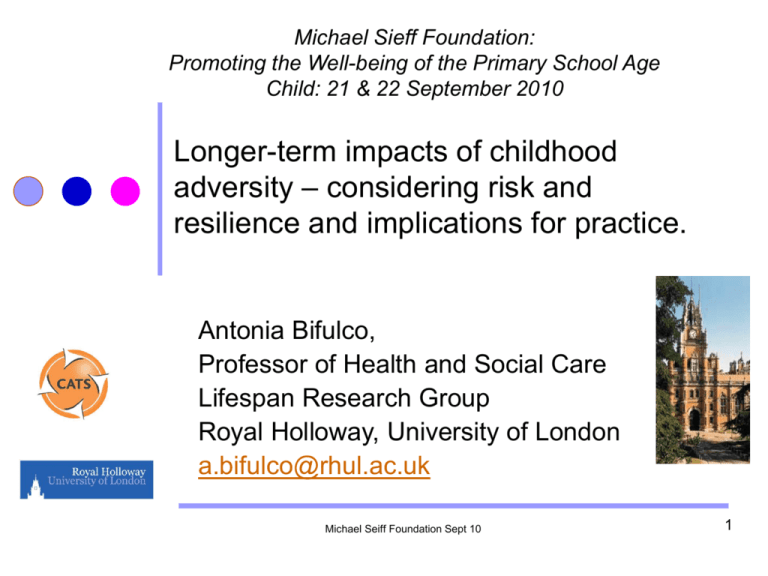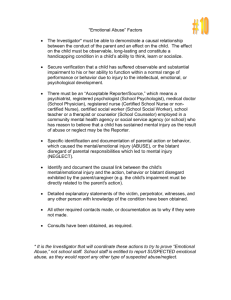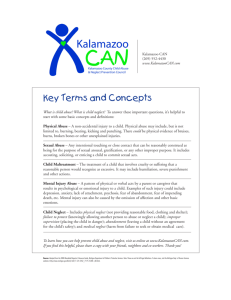
Michael Sieff Foundation:
Promoting the Well-being of the Primary School Age
Child: 21 & 22 September 2010
Longer-term impacts of childhood
adversity – considering risk and
resilience and implications for practice.
Antonia Bifulco,
Professor of Health and Social Care
Lifespan Research Group
Royal Holloway, University of London
a.bifulco@rhul.ac.uk
Michael Seiff Foundation Sept 10
1
The Lifespan Research Group
We undertake academic research into lifespan and
intergenerational risk factors for psychological disorders –
with a focus on parents and adolescents.
Using a lifespan approach with focus on key transitions
(such as adolescence) in relation to parental
neglect/abuse in childhood.
Utilising interview measures which are sensitive to
narrative and meaning, yet amenable to quantitative
analyses (eg CECA and ASI)
We also undertake applied research with social care and
health services to aid with evidence-based practice &
training in assessment.
Michael Seiff Foundation Sept 10
2
Aim of presentation
To examine longer term effects of childhood
adversity in relation to adolescent and adult
psychological disorder.
To examine risk and resilience models in an
Attachment Framework
To discuss gaps in research and methods for
primary school-age children.
To consider implications for health and social
care practice
Michael Seiff Foundation Sept 10
3
Risks in UK adolescents
UNICEF report (2007)
Young people in UK report worse levels of well-being
in Europe
Mental health rates increased (Maughan, Meltzer &
Goodman (2008)
Teenagers in the UK have high rates of psychological
disorder compared to other Western countries. These
increased up to 1999. Although evidence of
stabilising, teacher report of emotional disorder
increasing up to 2004 Nuffield Foundation, 2009).
Other risk factors
teenage pregnancy, family break down,
neglect/abuse, risk taking behaviour, violent
environments are all common in UK youth
Michael Seiff Foundation Sept 10
4
Risks in UK adults
High rates of family breakdown,
divorce and single parenthood
High rates of domestic violence
High rates of depression, anxiety and
substance abuse
Variable treatment coverage (primary
care provision, but rationed)
Michael Seiff Foundation Sept 10
5
What is childhood adversity?
FAMILY CONTEXT
Deprivation: Family context of poverty, housing
difficulty, parental physical or mental illness,
Conflict: domestic conflict and violence.
Unstable family structure – single parent, reconstituted families
BEHAVIOUR TOWARDS CHILD
Poor relationships with parents (antipathy, discord, low
supervision, high discipline)
Maltreatment (neglect, physical abuse, sexual abuse,
psychological abuse).
All these factors are inter-related. Some evidence of
increase.
Michael Seiff Foundation Sept 10
6
Adversity for children and parents occur in
the same context….
FAMILY CONTEXT
Family
Deprivation
Partner Conflict
Family
structure
Parent
Psychological
disorder
BEHAVIOUR TO CHILD
Poor parentChild relationship
Child
Maltreatment
Child
Psychological
disorder
Family context, parenting and
maltreatment
Study of family factors, parenting and
maltreatment and psychological
disorder in offspring shows that
maltreatment is the most significant
factor. Specifically:
Neglect
Physical abuse
Sexual abuse
Psychological abuse
Michael Seiff Foundation Sept 10
8
Summary of Lifespan
findings on CECA and
psychological disorder.
Community series of adult women
and of adolescents.
Michael Seiff Foundation Sept 10
9
Lifespan Intergenerational
Community Samples
Community mothers (1980-5; 1990-5) registered with
London GP surgeries studied prospectively to
determine lifetime vulnerability to depression
(i) Representative 1980-5 (n=210)
(ii) Vulnerable 1990-5 (n=303)
Community Offspring – to test transmission of risk to
adolescent/young adult offspring
(i) Sons and daughters of Representative mothers
1989-92, (n=172)
(ii) Sons and daughters of Vulnerable mothers 1995-99
(n=146)
Michael Seiff Foundation Sept 10
10
Standardised, contextual, interview
measures used
Childhood Experience of Care and
Abuse (CECA)
(Bifulco & Moran 1998)
Attachment Style Interview
(Bifulco et al 2002)
SCID DSM-IV for clinical disorder
(First et al, 1996)
Michael Seiff Foundation Sept 10
11
The Childhood Experience of Care
and Abuse Interview (CECA)
(Bifulco & Moran, 1998)
A retrospective measure of early life
experience used with adolescents or adults.
Covers relationship with parents, family
context and neglect and abuse directed to
child.
Assesses severity, age at onset, duration,
frequency etc of a range of negative
experience before age 17.
Has good reliability and validity.
Michael Seiff Foundation Sept 10
12
CECA Neglect
Material neglect and indifference
shown by parents and carers
to child in relation to:
material care (being fed,
clothed); regular household
routines; health & hygiene.
Socialisation: neglect of
friendships, school work,
career options
Emotional needs & support
Severity determined by
pervasiveness of neglect and
number of areas of neglect
Michael Seiff Foundation Sept 10
Rated:
1. Marked ] Severe
2. Moderate ] Severe
3. Mild
4. Little/none
Scored
For each abuse by different
perpetrator
For changes in severity over
time
13
CECA Physical abuse
Violence shown to child from
household member. Includes
severe beatings, being hit with
implement, punched, kicked,
burned. Potential for causing
injury. Usually repeated but can
be single severe attack, usually
from adult, but maybe older
child/young person.
Severity determined by intensity
of attack, type of hitting and
frequency.
Michael Seiff Foundation Sept 10
Rated:
1. Marked ] Severe
2. Moderate ] Severe
3. Mild
4. Little/none
Scored
For each abuse by
different perpetrator
For changes in severity
over time
14
CECA Sexual abuse
Sexual behaviour to child by any adult
or older child/young person.
Usually sexual contact but can
include verbal solicitation,
observing sexual activity/
pornography. With or without force.
Perpetrator can be any relationship
to child or stranger. Can be single
incident or repeated.
Severity determined by degree of
contact, repeated nature,
relationship to other.
Michael Seiff Foundation Sept 10
Rated:
1. Marked ] Severe
2. Moderate ] Severe
3. Mild
4. Little/none
Scored
For each abuse by
different perpetrator
For changes in severity
over time
15
CECA Psychological
Abuse
Sadistic & cruel behaviour,
coercive control of the child
involving:
Rated:
1. Marked ] Severe
2. Moderate ] Severe
3. Mild
4. Little/none
humiliation, extreme rejection
deprivation of basic needs or
valued objects,
inflicting marked
discomfort/distress,
Scored
Terrorising
For each abuse by different
Cognitive disorientation
perpetrator
Emotional blackmail or
For changes in severity over
exploitation.
time
Severity determined by intensity ,
number of categories of abuse
and frequency.
Michael Seiff Foundation Sept 10
16
Prevalence of maltreatment
Experiences of severe neglect, physical or
sexual abuse in childhood affects around 1
in 4 individuals (Bifulco & Moran, 1998).
(Also, see Cawson 2000: with 15% severe
neglect, 21% physical abuse, 18% sexual
abuse and 6% psychological abuse).
Although fairly common, most individuals
survive it (around two-thirds) in terms of
psychological disorder.
However there is variation in the multiples
of abuse and intensity which does increase
risk of negative outcome
Michael Seiff Foundation Sept 10
17
Neglect and abuse experience
relates to later clinical disorder
A range of negative childhood
experience relates to adult depression
and to a range of adolescent disorder.
The pattern is similar in both age
groups although higher in
adolescents.
Various dose-response effects are
observable.
Michael Seiff Foundation Sept 10
18
CECA experience and major depression in 12 months:
303 adult high-risk community women*
CECA dichotomy – peak
Odds
ratio
P<
Antipathy mother
1.94
.07
Antipathy father
2.93
.05
Lax control
1.78
.10
i) Neglect
3.18
.001
ii) Physical abuse
3.00
.001
iii) Sexual abuse
7.00
.001
iv) Psychological abuse
2.85
.007
INDEX i-iv NEGLECT OR ABUSE
3.96
.001
Relationship with parent
Maltreatment
CECA experience and any case disorder in 12 months –
276 young people 16-25 (representative & high risk)
CECA dichotomy – marked
or moderate severity
Odds ratio
P<
Antipathy mother
3.16
.001
Antipathy father
2.49
.01
Lax control
1.57
NS
i) Neglect
5.27
.0001
ii) Physical abuse
5.03
.0001
iii) Sexual abuse
7.88
.0001
INDEX (i-iii) NEGLECT OR
ABUSE
5.00
.001
Relationship parents
Maltreatment
Males and externalising disorder:
CECA experience and conduct disorder – young males
16-25, n=140
CECA dichotomy (marked or
moderate severity vs some,
little/none)– peak
Odds ratio
P<
Antipathy mother
5.0
.002
Antipathy father
11.0
.00001
Lax control
1.5
NS
i) Neglect
8.3
.01
ii) Physical abuse
7.0
.003
iii) Sexual abuse
10.0
.05
Index i-iii: Neglect/abuse
index
4.1
.03
Dose-Response effects (i) Multiple Abuse
The more the types of abuse the more likelihood of disorder – dose
response effect (303 adult community women)
% with adult depression
80
73
65
70
60
64
12 month
Chronic/
recurrent
53
50
28
30
20
35
35
40
23
23
9
10
0
0
1
2
3
4
Multiple abuse < 17
Severe neglect or physical or sexual or psychological abuse
Dose-response effects (ii) Severity of abuse
Severity of types of abuse and adult depression – dose response effect
(303 adult community women)
Physical
70
Sexual
Psychological
Neglect
% depression in 12 months
60
50
40
30
20
10
0
4-None
3-Some
2-Moderate
Severity of neglect/abuse
1-Marked
Family context and neglect/abuse
in childhood (303 adult women)
Parental conflict
X
Parental Loss
X 2.4
2.8
X
Severe neglect,
physical
or sexual abuse
2
Deprivation
X
3.2
Any 1 factor
(Relative risks given)
Bifulco & Moran, 1998
Teenage linking experiences
(303 Vulnerable women)
x 1.64
Neglect or
abuse <17
x 1.7
Teenage pregnancy
Lack of planning
re home leaving
x3
Teenage depression
17-20
Relative risks shown
Adult risk factors and neglect/abuse
in childhood (303 vulnerable women)
X
Violent partner
2.1
Neglect/abuse
<17
X
2.6
X
Adult sexual assault
1.6
Separation partner
Relative risks given
Role of previous pregnancy & marital experience
(303 vulnerable women)
Path analysis
.21
Neglect or
Abuse in
childhood
ns
Marital adversity
.33
.33
.29
ADULT
DEPRESSION
12 MONTHS
Severe loss
pregnancy
Bernazzani, Bifulco et al 2003
Role of insecure attachment
style- adults
Adult attachment examined as mediating
factor between childhood experience and
later adult disorder, both anxious and
avoidant active.
Adult attachment examined as mechanism
in maltreatment of children and in relation to
poor parenting capacity
Adolescent insecure anxious attachment
style mediates between maternal poor
parenting and emotional disorder.
Michael Seiff Foundation Sept 10
28
Attachment Theory
Bowlby, 1969-80 Attachment and Loss trilogy.
Attachment theory provides a useful framework
for investigating lifespan linkages between
early interactions between parent and child and
subsequent relationship style in adolescence
and adulthood.
Research evidence shows insecure attachment style
relates to:
childhood neglect/abuse (Crittenden 1997),
poorer support (Hazan & Shaver, 1994; Bartholomew &
Horowitz 1997),
stress (Mikulciner & Florian, 1998) and
psychological disorder in adolescence (Allen, 1998) and
adulthood (Mickelson & Kessler 1997)
Michael Seiff Foundation Sept 10
29
Attachment Style Interview (ASI)
Bifulco et al 2002
Assesses quality of relationship with partner
and 2-3 Very Close Others. At least 2 close
confiding relationships, provides good ability to
make and maintain relationships and denotes
Security.
Attitudes to closeness (mistrust, constraints on
closeness, fear of rejection, anger) and
autonomy (self-reliance, desire for company,
fear of separation) all assessed.
Profile from all information provides degree of
insecurity (marked, moderate, none) and type
of style:
Anxious (Enmeshed or Fearful)
Avoidant (Angry-Dismissive or Withdrawn)
Secure.
Michael Seiff Foundation Sept 10
30
Adult Lifespan analysis
Path analysis model
(303 Vulnerable community women)
.22
Poor support
.18
.37
Neglect/
abuse<17
.24
.32
Highly Insecure
Attachment style
.27
Teenage
depression
.30
.41
Negative Evaluation of self
Bifulco et al, 2002 a & b SPPE
.26
Adult
depression
Attachment style and depression –
specificity of style studied prospectively
(154 women seen over 3 year period)
Onset depression
Interview 2
Childhood experience ASI interview 1
At interview 1
Highly Enmeshed
ns
Neglect or
Abuse < 17
(CECA)
.19
.28
ns
Highly Fearful
Highly Angrydismissive
.26
.23
.19
ns
Onset
Major
Depression
Highly Withdrawn
Tests show partial mediation for Fearful and Angry-dismissive
Bifulco et al, 2006, SPPE
Model of neglect/abuse and attachment style in
adolescents
(146 adolescent offspring)
Mother’s
neglect or
Abuse <17
,25
Offspring Emotional
disorder
,46
Offspring
Negative Evaluation
of Self
,47
,36
e5
e4
Offspring Anxious
Attachment style
Bifulco A (2008) Risk and resilience in young Londoners. In (Eds, D. Brom,
R Pat-Horenczyk & J, Ford) Routledge, London, NY
Risk and resilience approaches
Before 1990 most research into adolescent
disorder examine the contribution of
different risks – psychological and social.
After work by Garmezy, Rutter, Masten and
others, the importance of ‘resilience’ was
recognised i.e. protective factors explaining
‘absence’ of disorder.
Research into high risk community samples
allow for investigation of both risk and
resilience for disorder
Michael Seiff Foundation Sept 10
34
Resilience
Protective factors are those which are
active in the presence of risk factors –
to buffer or moderate the impact.
In high risk adolescents, all
experienced some form of social
deprivation or maltreatment and 45%
had disorder – were the other’s
protected?
Michael Seiff Foundation Sept 10
35
High level of social risks in
sample of young people
94% had at least one of the following risk
factors:
Lone mother upbringing – 52%
Lowest social class – 32%
History of domestic violence between
parents – 21%
Maternal recurrent depressive disorder –
46%
Paternal disorder, including substance
abuse and criminal behaviour - 52%
Michael Seiff Foundation Sept 10
36
However, positive factors were
also common:
80% had at least one of the following positive
factors:
Support from friend age 16 - 56%
Positive peer group age 16 - 68%
Positive school characteristics age 16 - 66%
High academic attainment age 16 - 51%
High felt competence as student age 16 - 66%
Clearly Secure attachment style at interview - 30%
Markedly high self acceptance at interview - 14%
Michael Seiff Foundation Sept 10
37
Model of positive factors for
emotional disorder
Logistic regression – outcome emotional disorder 12 months
Variable
OR
Wald
Df
P<
Positive school
character
0.73
0.51
1
NS
Positive peer group
0.65
0.91
1
NS
Marked self
acceptance
0.05
3.79
1
.05
Secure attachment
style
0.20
7.34
1
.007
Marked self acceptance and secure attachment style provide the
Best model in relating to absence of disorder -Goodness of fit 71.7%
Protective effect of secure attachment
or marked self acceptance
60
% Case emotional disorder
50
48
40
35
No positive
psychological
30
25
20
Positive
psychological
10
6
0
No severe abuse
Severe abuse
Model of emotional disorder
Logistic regression – outcome internalising disorder 12 months
Variable
OR
Wald
Df
P<
Neglect/abuse from 1.63
mother
4.63
1
.03
Secure attachment
0.22
6.82
1
.009
Marked self
acceptance
0.13
3.73
1
.05
Secure attachment and marked self acceptance add to the model in
Producing lower disorder in the presence of neglect/abuse
Goodness of fit 74.7%
Implications for practice
Assessment: Need standardised assessment tools for
reliable and valid measurement of child and families
experience.
Analysis: Important to assess severity of neglect or
abuse using standardised criteria. Need to assess
multiples of abuse to estimate risk. Some risk factors
more damaging than others.
Attachment Frameworks need to assess attachment
style in adolescence and childhood to determine
impacts of adversity and resilience.
Michael Seiff Foundation Sept 10
41
Ongoing Lifespan collaborations
with services.
St Christopher’s residential care
services – assessing attachment style
in young people in care prior to social
learning intervention.
Kingston Safeguarding services –
using CECA scoring framework to rate
case information to aid with
classification and analysis of
neglect/abuse of children.
Michael Seiff Foundation Sept 10
42
Trainings offered for social
workers and psychologists
Childhood Experience of care and abuse –
for forensic psychologists and social
workers in safeguarding.
Attachment Style Interview for parents
Attachment Style Interview for adolescents
Parenting role Interview
www.cecainterview.com
www.attachmentstyleinterview.com
Michael Seiff Foundation Sept 10
43
Research implications: studying
primary school age children
Measurement – need for intensive
contextualised measures which can be
used in younger age groups.
Gap in primary school group for
attachment measures and face-toface direct assessments.
Need to amplify Attachment
Frameworks to include social adversity
and biological variables.
Michael Seiff Foundation Sept 10
44
Research implications: studying
primary school age children
Need to re-use social lifespan and stress
models. Importance of life events in younger
age groups.
Neglect/abuse variables in adult summarise
long periods of childhood. When asking
children we need to break the experience
into events and difficulties using a timeframe
(eg Sandberg & Rutter, 1993 - PACE ).
.
Michael Seiff Foundation Sept 10
45








